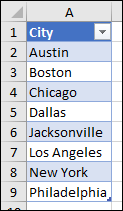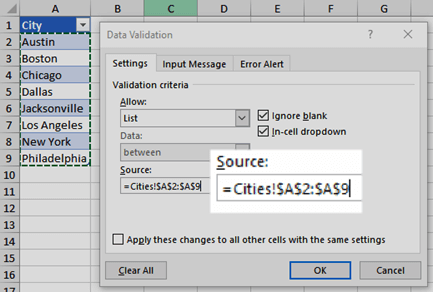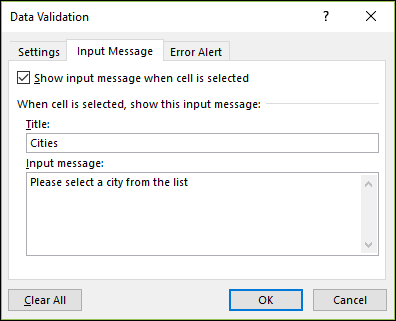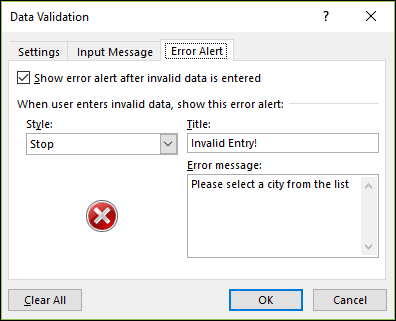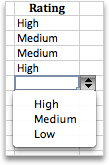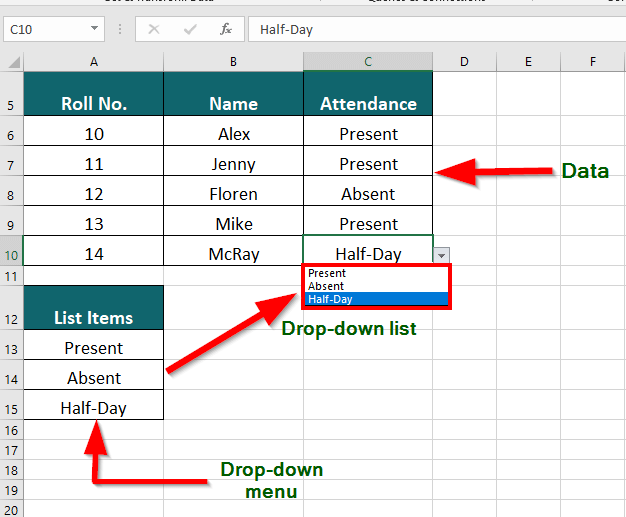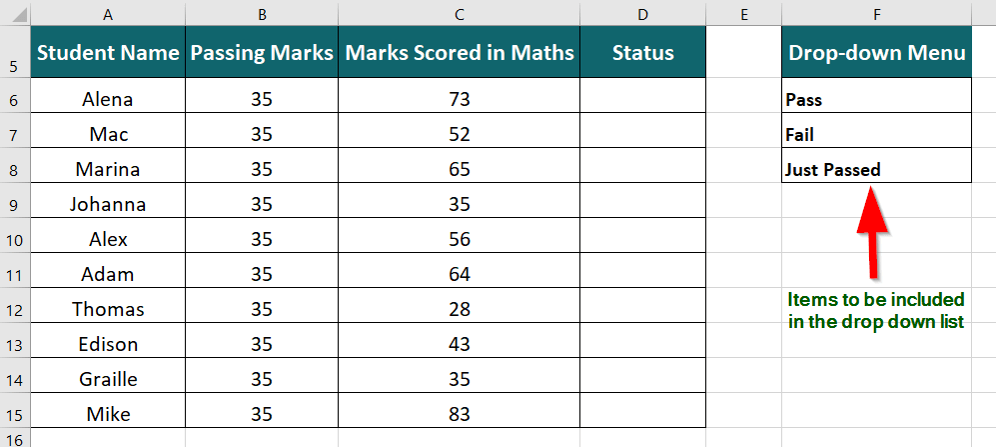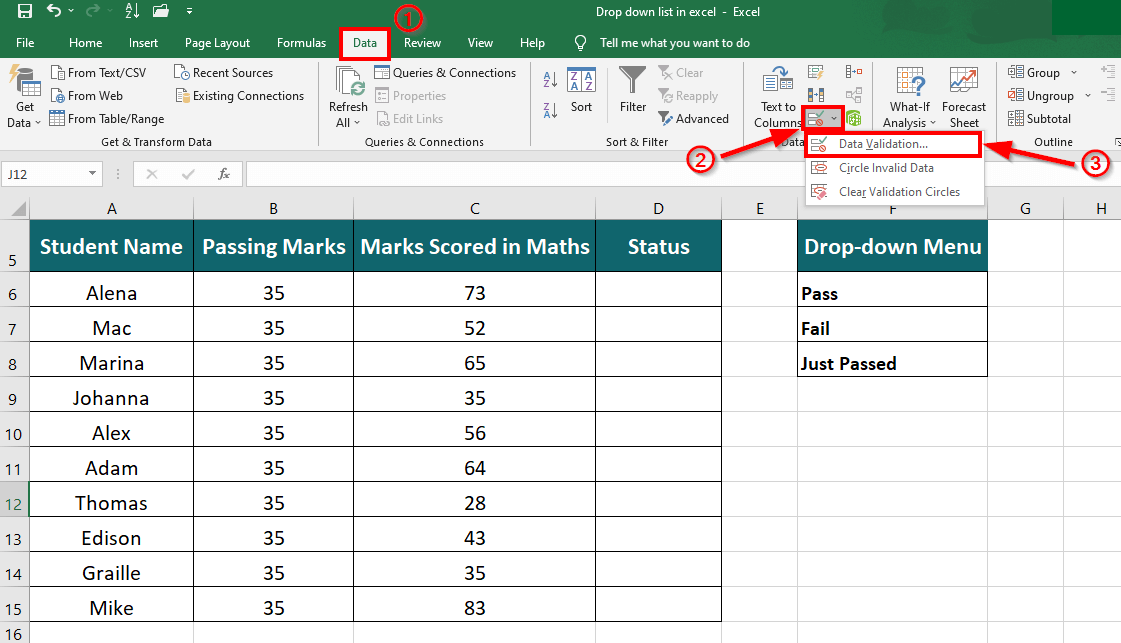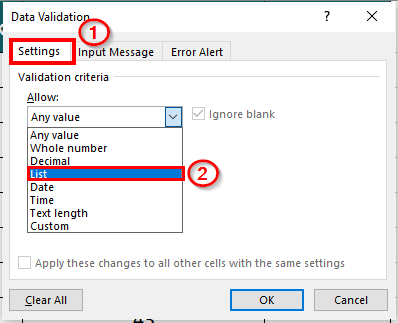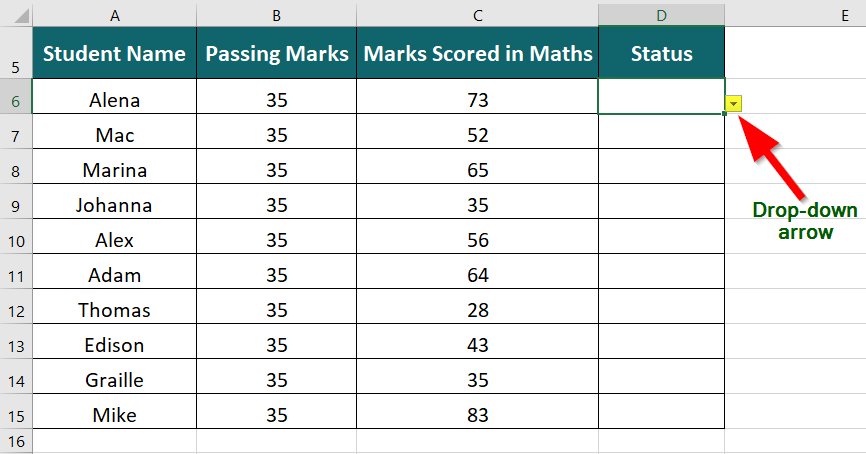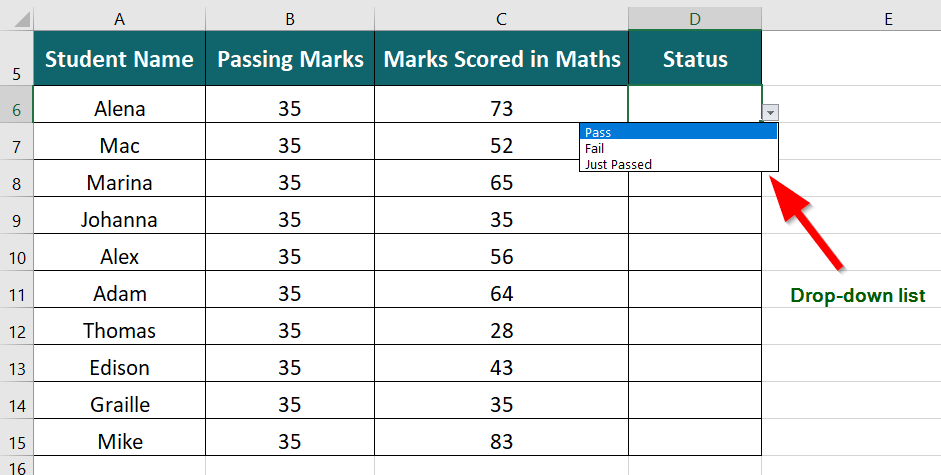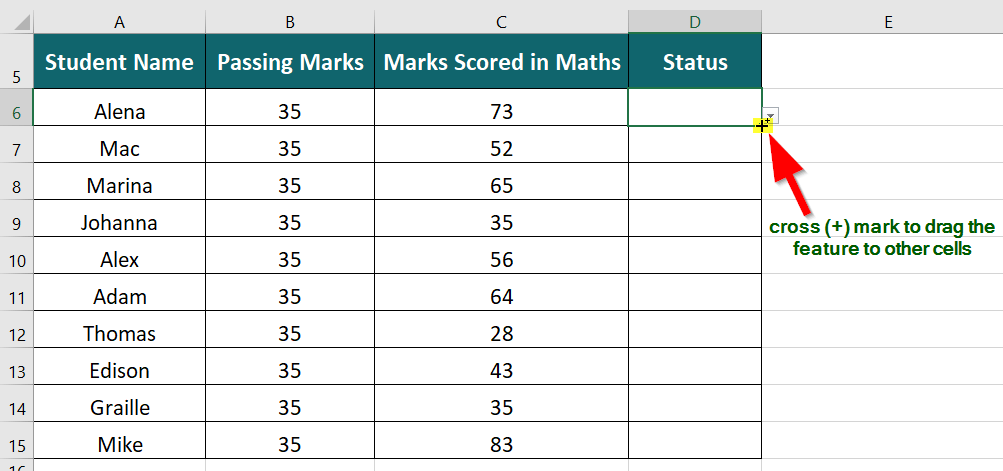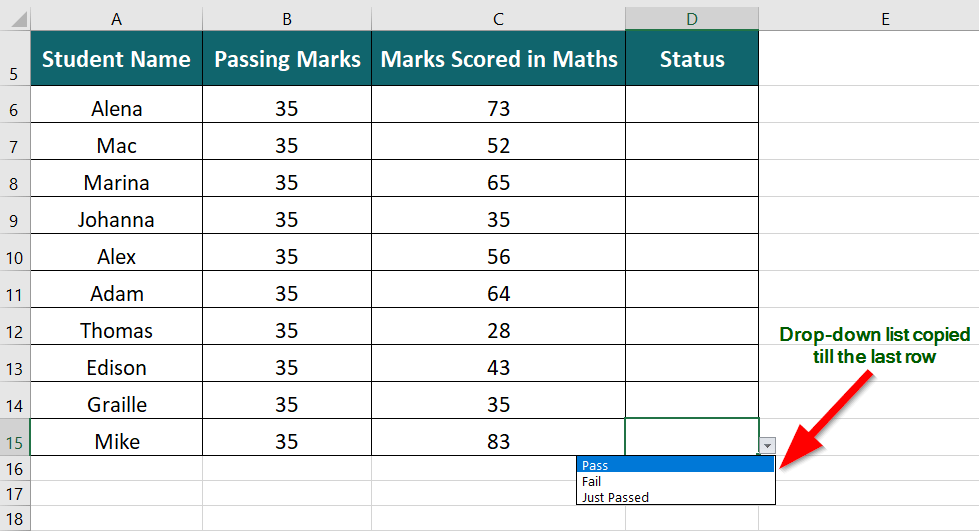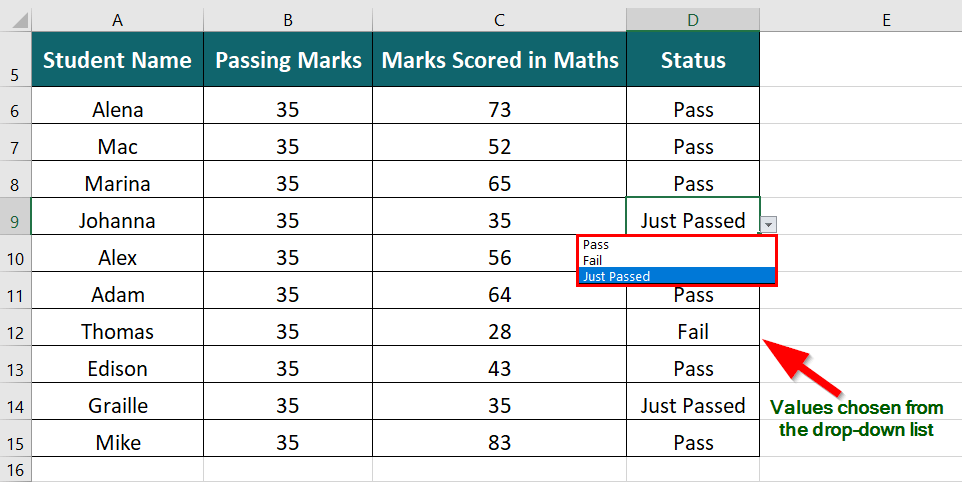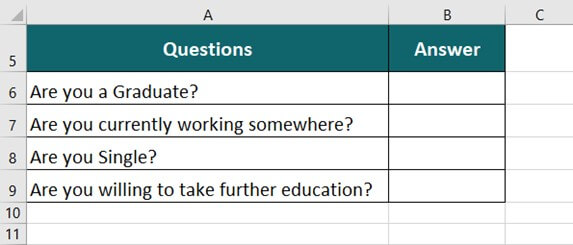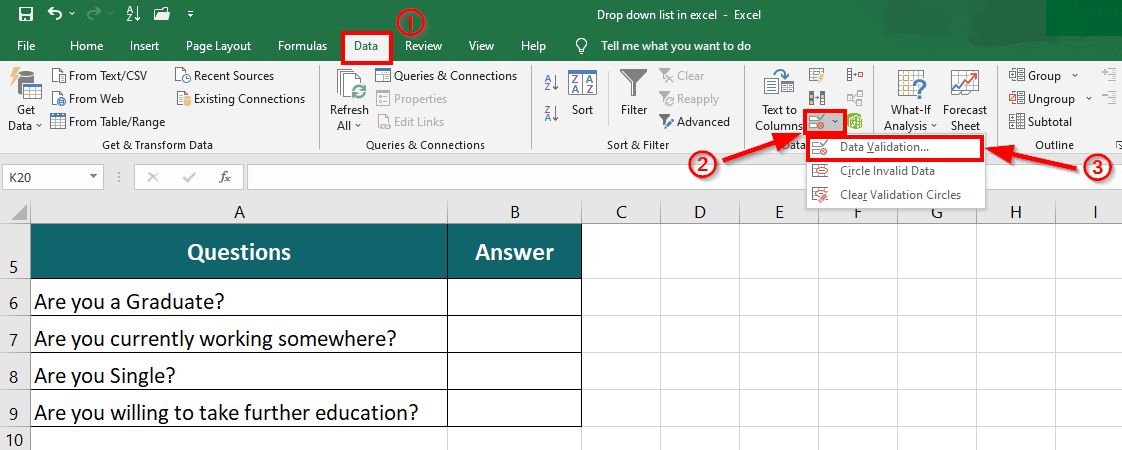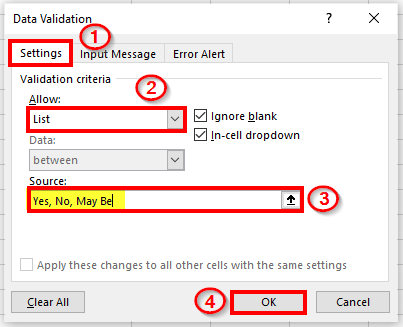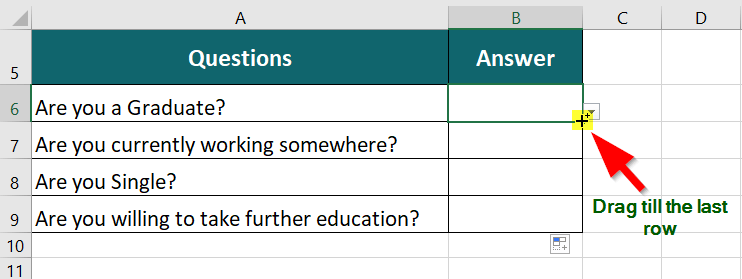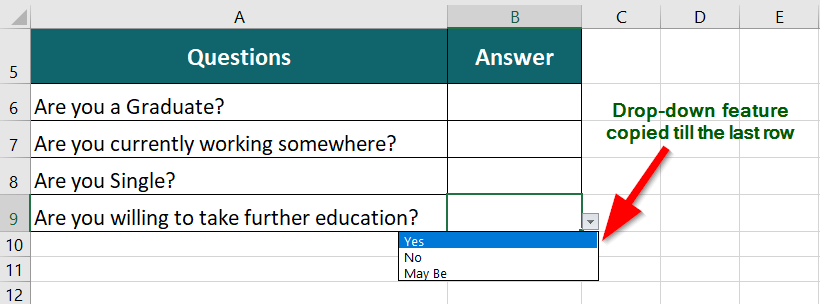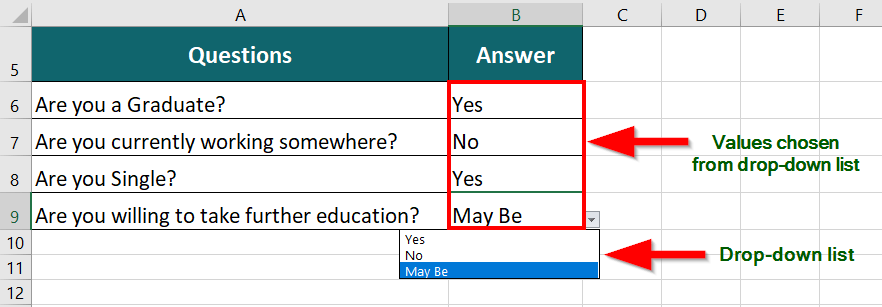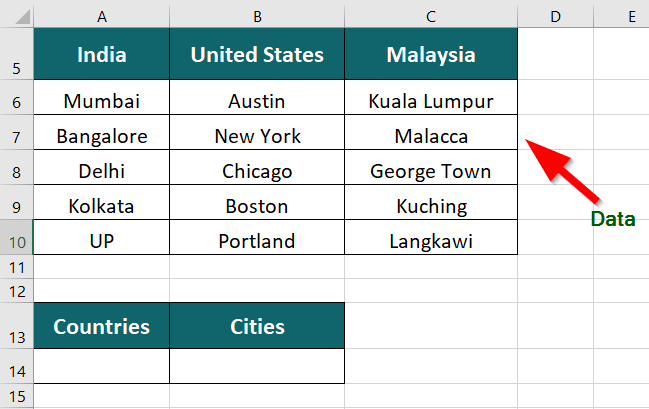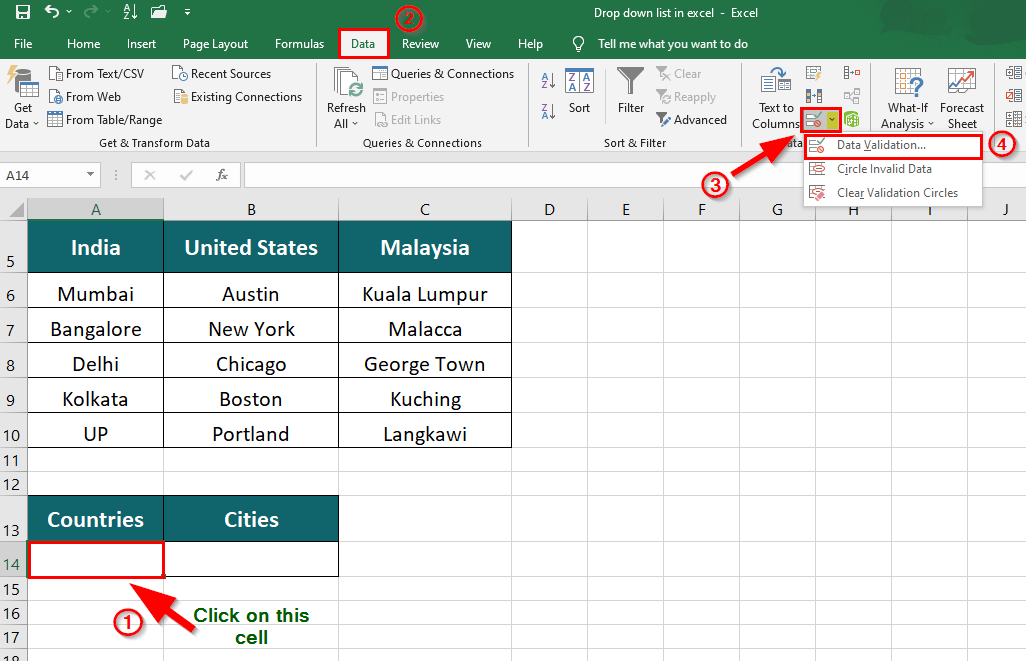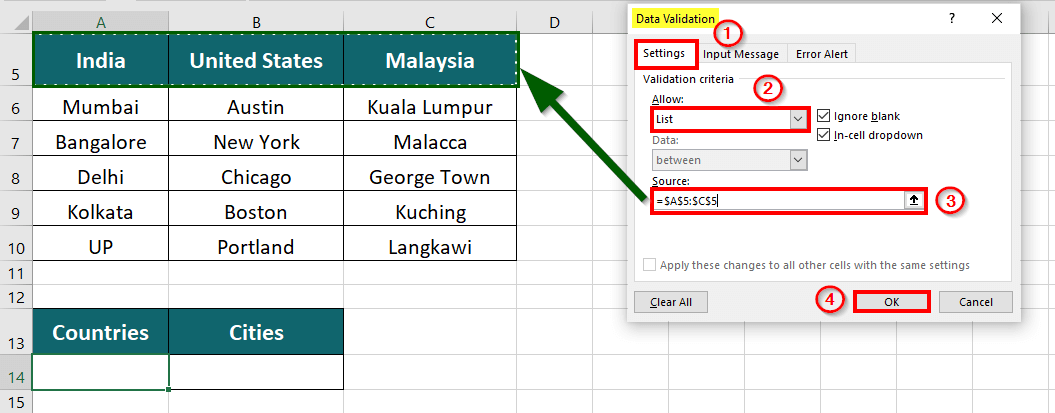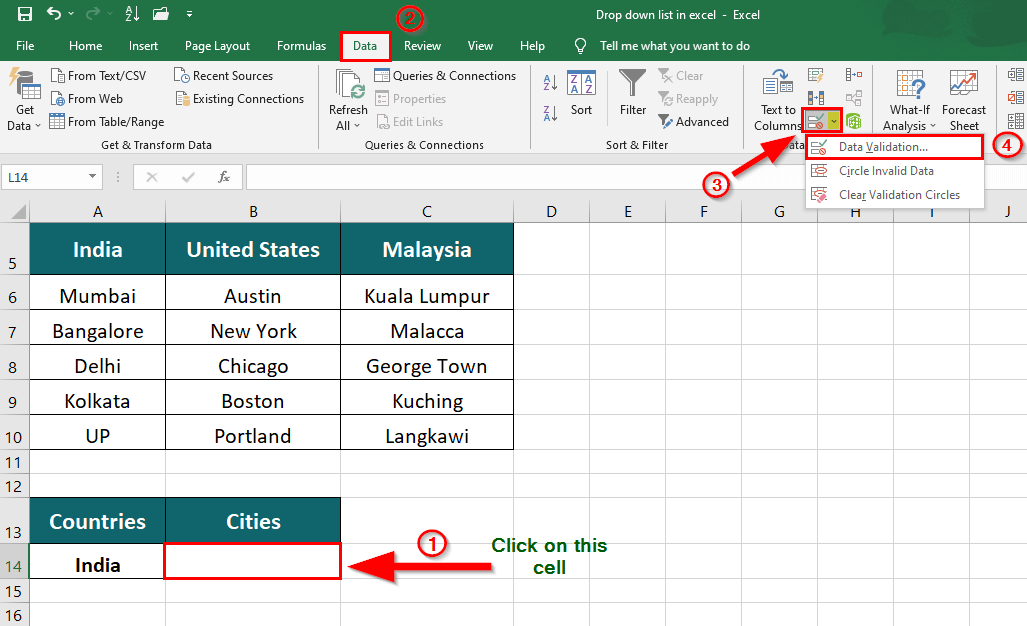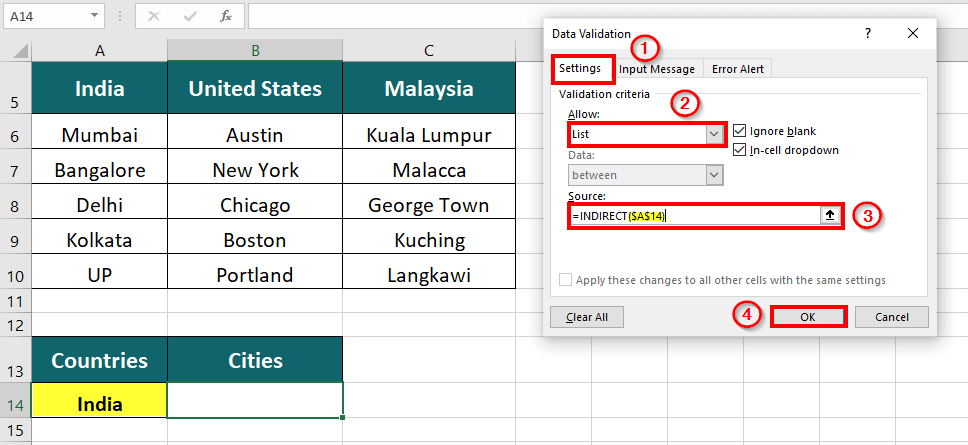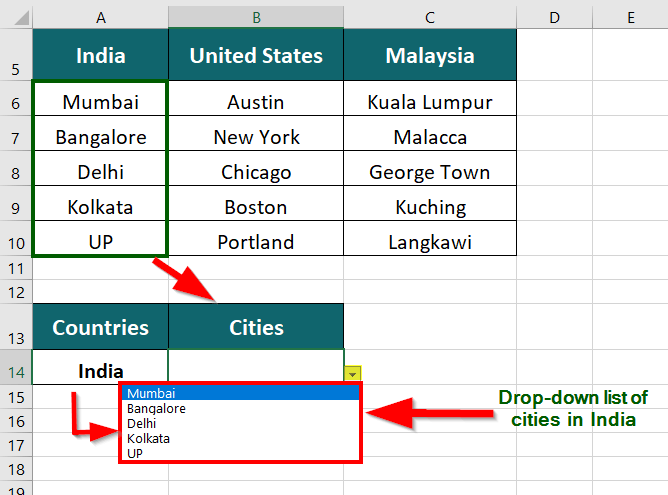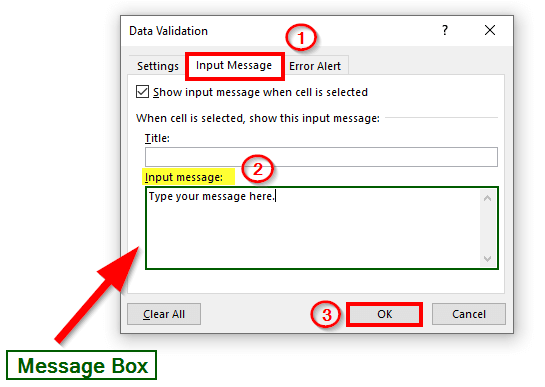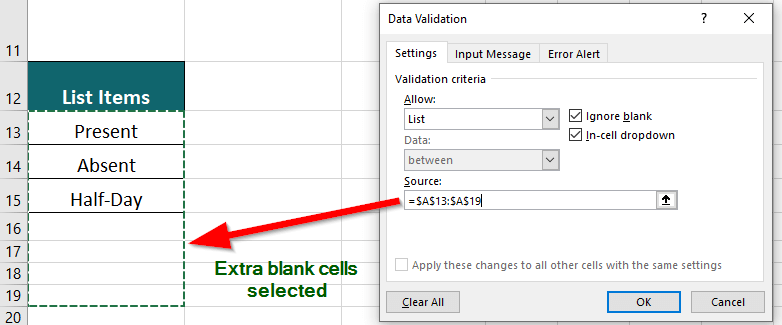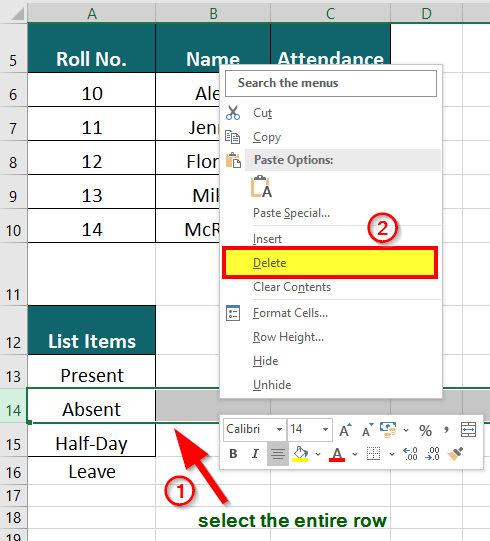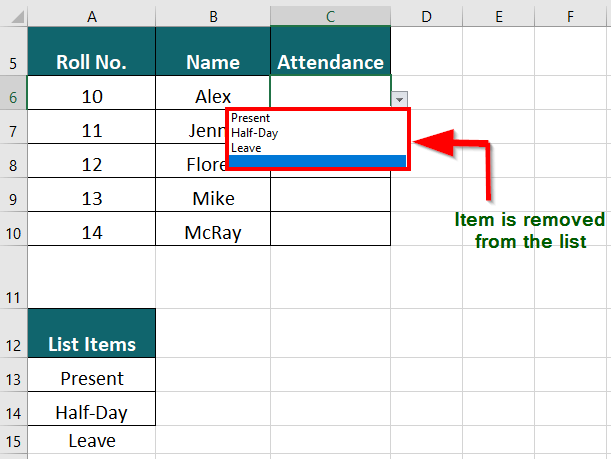- Drop-down lists
- Want more?
- Create a drop-down list
- See also
- Need more help?
- Drop Down List in Excel
- What is Drop Down List in Excel?
- Key Highlights
- How to Create Drop Down List in Excel?
- #1: Using List Items
- #2: Using the Comma-Separated Values
- #3: Creating Dependent Drop-down List
- Things to Remember
- Frequently Asked Questions (FAQs)
Drop-down lists
Data entry is quicker and more accurate when you use a drop-down list to limit the entries people can make in a cell. When someone selects a cell, the drop-down list’s down-arrow appears, and they can click it and make a selection.
Create a drop-down list
You can make a worksheet more efficient by providing drop-down lists. Someone using your worksheet clicks an arrow, and then clicks an entry in the list.
Select the cells that you want to contain the lists.
On the ribbon, click DATA > Data Validation.
In the dialog, set Allow to List.
Click in Source, type the text or numbers (separated by commas, for a comma-delimited list) that you want in your drop-down list, and click OK.
Want more?
Data entry is quicker and more accurate when you use a drop-down list to limit the entries that people can make in a cell.
When you select a cell, the drop-down list’s down-arrow appears, click it, and make a selection.
Here is how to create drop-down lists: Select the cells that you want to contain the lists.
On the ribbon, click the DATA tab, and click Data Validation.
In the dialog, set Allow to List.
Click in Source.
In this example, we are using a comma-delimited list.
The text or numbers we type in the Source field are separated by commas.
And click OK. The cells now have a drop-down list.
Create a drop-down list
You can help people work more efficiently in worksheets by using drop-down lists in cells. Drop-downs allow people to pick an item from a list that you create.
In a new worksheet, type the entries you want to appear in your drop-down list. Ideally, you’ll have your list items in an Excel table . If you don’t, then you can quickly convert your list to a table by selecting any cell in the range, and pressing Ctrl+T .
Why should you put your data in a table? When your data is in a table, then as you add or remove items from the list , any drop-downs you based on that table will automatically update. You don’t need to do anything else.
Now is a good time to Sort data in a range or table in your drop-down list.
Select the cell in the worksheet where you want the drop-down list.
Go to the Data tab on the Ribbon, then Data Validation .
Note: If you can’t click Data Validation , the worksheet might be protected or shared. Unlock specific areas of a protected workbook or stop sharing the worksheet, and then try step 3 again.
On the Settings tab, in the Allow box, click List .
Click in the Source box, then select your list range. We put ours on a sheet called Cities, in range A2:A9. Note that we left out the header row, because we don’t want that to be a selection option:
If it’s OK for people to leave the cell empty, check the Ignore blank box.
Check the In-cell dropdown box.
Click the Input Message tab.
If you want a message to pop up when the cell is clicked, check the Show input message when cell is selected box, and type a title and message in the boxes (up to 225 characters). If you don’t want a message to show up, clear the check box.
Click the Error Alert tab.
If you want a message to pop up when someone enters something that’s not in your list, check the Show error alert after invalid data is entered box, pick an option from the Style box, and type a title and message. If you don’t want a message to show up, clear the check box.
Not sure which option to pick in the Style box?
To show a message that doesn’t stop people from entering data that isn’t in the drop-down list, click Information or Warning. Information will show a message with this icon 

To stop people from entering data that isn’t in the drop-down list, click Stop .
Note: If you don’t add a title or text, the title defaults to «Microsoft Excel» and the message to: «The value you entered is not valid. A user has restricted values that can be entered into this cell.»
After you create your drop-down list, make sure it works the way you want. For example, you might want to check to see if Change the column width and row height to show all your entries.
If the list of entries for your drop-down list is on another worksheet and you want to prevent users from seeing it or making changes, consider hiding and protecting that worksheet. For more information about how to protect a worksheet, see Lock cells to protect them .
If you decide you want to change the options in your drop-down list, see Add or remove items from a drop-down list .
To delete a drop-down list, see Remove a drop-down list .
You can download an example workbook with multiple data validation examples like the one in this article. You can follow along, or create your own data validation scenarios. Download Excel data validation examples .
Data entry is quicker and more accurate when you restrict values in a cell to choices from a drop-down list.
Start by making a list of valid entries on a sheet, and sort or rearrange the entries so that they appear in the order you want. Then you can use the entries as the source for your drop-down list of data. If the list is not large, you can easily refer to it and type the entries directly into the data validation tool.
Create a list of valid entries for the drop-down list, typed on a sheet in a single column or row without blank cells.
Select the cells that you want to restrict data entry in.
On the Data tab, under Tools , click Data Validation or Validate .
Note: If the validation command is unavailable, the sheet might be protected or the workbook may be shared. You cannot change data validation settings if your workbook is shared or your sheet is protected. For more information about workbook protection, see Protect a workbook .
Click the Settings tab, and then in the Allow pop-up menu, click List .
Click in the Source box, and then on your sheet, select your list of valid entries.
The dialog box minimizes to make the sheet easier to see.
Press RETURN or click the Expand 
You can also type values directly into the Source box, separated by a comma.
To modify the list of valid entries, simply change the values in the source list or edit the range in the Source box.
You can specify your own error message to respond to invalid data inputs. On the Data tab, click Data Validation or Validate , and then click the Error Alert tab.
See also
In a new worksheet, type the entries you want to appear in your drop-down list. Ideally, you’ll have your list items in an Excel table .
Why should you put your data in a table? When your data is in a table, then as you add or remove items from the list , any drop-downs you based on that table will automatically update. You don’t need to do anything else.
Now is a good time to Sort your data in the order you want it to appear in your drop-down list.
Select the cell in the worksheet where you want the drop-down list.
Go to the Data tab on the Ribbon, then click Data Validation .
On the Settings tab, in the Allow box, click List .
If you already made a table with the drop-down entries, click in the Source box, and then click and drag the cells that contain those entries. However, do not include the header cell. Just include the cells that should appear in the drop-down. You can also just type a list of entries in the Source box, separated by a comma like this:
If it’s OK for people to leave the cell empty, check the Ignore blank box.
Check the In-cell dropdown box.
Click the Input Message tab.
If you want a message to pop up when the cell is clicked, check the Show message checkbox, and type a title and message in the boxes (up to 225 characters). If you don’t want a message to show up, clear the check box.
Click the Error Alert tab.
If you want a message to pop up when someone enters something that’s not in your list, check the Show Alert checkbox, pick an option in Type , and type a title and message. If you don’t want a message to show up, clear the check box.
After you create your drop-down list, make sure it works the way you want. For example, you might want to check to see if Change the column width and row height to show all your entries. If you decide you want to change the options in your drop-down list, see Add or remove items from a drop-down list . To delete a drop-down list, see Remove a drop-down list .
Need more help?
You can always ask an expert in the Excel Tech Community or get support in the Answers community.
Drop Down List in Excel
What is Drop Down List in Excel?
A drop-down list in Excel is a feature that allows you to choose an option from a list that appears when you click on a cell. It’s like a menu where you can pick what you want to eat. With a drop-down list, you can limit the options that someone can select to make sure they choose the correct information. We can use it to keep employee attendance records, perform large accounting data entry, or in financial modeling.
For example, we can use a drop-down list in Excel to mark student attendance in a class, reducing the risk of manual entry errors.
Excel functions, formula, charts, formatting creating excel dashboard & others
Key Highlights
- Dropdown lists in Excel involve a simple click on the drop-down arrow and offer an easy and efficient way to select the option we desire.
- This reduces the likelihood of making typos or errors that can occur with manual entry, improving the accuracy of data.
- The use of dropdown lists also helps to maintain the consistency and accuracy of data, which is especially important for tasks such as data analysis and reporting.
- Whenever we attempt an invalid entry, Excel displays an error alert message.
- It is possible to add new values to the dropdown list by simply adding them to the list items, giving users greater flexibility and ensuring that the list is always up-to-date.
How to Create Drop Down List in Excel?
#1: Using List Items
To create a drop-down list using list items, follow these steps:
- Select the cell for which you want to create a drop-down list
- Go to Data
- Under the Data Tools group click on the Data Validation (icon)
- Click on Settings
- Choose List from the drop-down of the “Allow” section
- Specify the source by selecting the list items (drop-down menu) in the worksheet.
- Click OK.
Consider the below example which demonstrates the steps in detail:
A teacher has a table of students’ Maths test marks and passing marks. They need to easily determine which students have passed, just passed, or failed. To simplify this task, the teacher wants to create a drop-down menu for selecting the appropriate result for each student.
Solution:
Step 1: Write drop-down menu options in column F
Step 2: Click on the cell where you want to insert a drop-down list and
Go To Data > under Data Tools click on the Data Validation drop-down > Data Validation
A Data Validation dialogue box will display
Step 3: Click on Settings > choose List from the drop-down of Allow
Step 4: Enter the Source by selecting the “Drop-down Menu” in the worksheet.
Step 5: Click OK.
This will insert a drop-down arrow adjacent to the selected cell.
Step 6: Click on the drop-down arrow to view the list items.
Output: The values Pass, Fail, and Just Passed are added as the drop-down list items. We can choose the desired item to fill in the cell.
Step 7: Simply drag the cross (+) to the desired row to add the drop-down list to the remaining cells.
This will copy the feature and insert a drop-down list till the last cell.
Step 8: To indicate a student’s test result based on their marks in Maths, select Pass from the drop-down list if they scored above 35 marks, select Just Passed if they scored 35 marks, and select Fail if they scored less than 35 marks.
#2: Using the Comma-Separated Values
To create a drop down list in Excel using the Comma-separated value method, follow the given steps:
- Select the cell for which you want to create a drop-down list
- Go to Data
- Under the Data Tools group click on Data Validation (icon)
- Click on Settings
- Choose List from the drop-down of the “Allow” section
- Type the values that you want to add to the list
- Click OK.
Consider the below example which demonstrates these steps in detail:
The table below shows a list of questions that candidates appearing for an interview need to answer. We want to create a drop-down list that would allow the candidates to choose from three options- Yes, No, or May Be.
Solution:
Step 1: Click on the desired cell
Step 2: Go To Data > click on the Data Validation drop-down under Data Tools group > Data Validation
A Data Validation dialogue box will pop-up
Step 3: Click on Settings > choose List from the drop-down of Allow
Step 4: In the Source section, enter the values- Yes, No, May Be
Step 5: Click OK
This inserts a drop-down arrow adjacent to the selected cell.
Step 6: Click on the drop-down arrow to view the list items- Yes, No, and May Be.
Step 7: Drag the cross (+) to the last row to insert the drop-down list into the remaining cells.
Excel adds the drop-down feature to all the rows.
Step 8: To fill the data table choose the appropriate answer from the drop-down list.
#3: Creating Dependent Drop-down List
To create a dependent drop-down list, follow the steps:
- Select the cell that contains for which you want to create the main drop-down list
- Go to Data
- Under the Data Tools group click on Data Validation (icon)
- Click on Settings
- Choose List from the drop-down of the “Allow” section
- Specify the source by selecting the list items (drop-down menu) in the worksheet.
- Click OK.
- Select the cell where you want to create a dependent drop-down list
- Go to Data
- Under the Data Tools group click on Data Validation (icon)
- Click on Settings
- Choose List from the drop-down of the “Allow” section
- Under the Source section type the formula, =INDIRECT(cell containing main drop-down list)
- Click OK.
The below example demonstrates the above steps in detail:
The table below mentions 3 countries- India, the United States, and Malaysia along with their popular cities. We want to create a drop down list so that whenever a user chooses a specific country it displays the respective cities in the list.
Solution:
Step 1: Click on cell C14 to create a drop-down list of the countries- India, the United States, and Malaysia
Step 2: In the Excel, ribbon go to Data > under Data Tools group click on Data Validation (icon) > Data Validation
A Data Validation dialogue box appears on the screen.
Step 3: Click on Settings > choose List from the drop-down of Allow and specify the Source by selecting the countries (row 5) in the worksheet
Step 4: Click OK.
Step 5: This will create a drop-down list of the country names
Step 6: To create a dependent drop-down list of cities select the cell B14
Step 7: Go To Data > under Data Tools click on Data Validation drop-down > Data Validation
A Data Validation dialogue box will appear
Step 8: Click on Settings > choose List from the drop-down of Allow
Step 9: To specify the Source enter the formula,
=INDIRECT($A$14) and click OK.
Explanation: Here, we want the drop-down list(of cities) to change as per the country. It means the drop-down list will depend upon another drop-down list, therefore, it is known as a dependent drop-down list.
So, to insert a dependent drop-down list we use the function INDIRECT followed by the cell with country names in closed brackets.
Output: A dynamic drop-down list of cities is added in cell B14.
Each time you choose a different country the dependent drop-down displays a list of cities belonging to that country.
Things to Remember
- While creating a drop-down list we can add a message from the Input Message tab in the Data Validation dialogue box. It will display a message (instruction) whenever a user clicks on the cell.
- Keep the list size reasonable and consider using scroll bars or combo boxes for longer lists.
- Ensure that the data source for the drop-down list is accurate and up-to-date.
- Consider customizing your drop-down lists with sorting options, color coding, or other formatting changes.
- Keep in mind that drop-down lists may not work in all versions of Excel or with all other software programs. Therefore, test your lists for compatibility with intended users and applications.
Frequently Asked Questions (FAQs)
What is the difference between a list and a dropdown?
A list and a dropdown are tools that let you give users a set of options to choose from in Excel. But they have some differences. A list shows the options in a column or row, while a dropdown is a button that opens up a list when you click it. Also, a list can be as big as the worksheet, while a dropdown has a limited display size.
How do I add or remove items from a drop-down list in Excel?
Prerequisite: While creating a drop-down list select extra blank cells while specifying the source.
To Add an item to a drop down list enter the new value into the List Items menu. Excel will automatically insert the new value into the drop down list.
To Remove/ Delete an item from the drop down list:
Step 1: Select the entire row containing the desired value. This will shift the cells up when the value is removed.
Step 2: Right-click the selected row
Step 3: Select Delete from the menu.
How to remove drop down list in Excel?
To remove drop down in Excel
Step 1: Select the cell from which you want to remove the drop down list
Step 2: Go to Data > Under Data Tools click on Data Validation > Clear All > OK.
Clear All > OK» width=»1031″ height=»490″ data-lazy-srcset=»https://cdn.educba.com/academy/wp-content/uploads/2019/05/2023-02-21-10_17_38-Greenshot.png 1031w, https://cdn.educba.com/academy/wp-content/uploads/2019/05/2023-02-21-10_17_38-Greenshot-300×143.png 300w, https://cdn.educba.com/academy/wp-content/uploads/2019/05/2023-02-21-10_17_38-Greenshot-1024×487.png 1024w, https://cdn.educba.com/academy/wp-content/uploads/2019/05/2023-02-21-10_17_38-Greenshot-768×365.png 768w» data-lazy-sizes=»(max-width: 1031px) 100vw, 1031px» data-lazy-src=»https://cdn.educba.com/academy/wp-content/uploads/2019/05/2023-02-21-10_17_38-Greenshot.png»/>
Clear All > OK1″ width=»842″ height=»541″ data-lazy-srcset=»https://cdn.educba.com/academy/wp-content/uploads/2019/05/2023-02-21-10_37_02-Greenshot.png 842w, https://cdn.educba.com/academy/wp-content/uploads/2019/05/2023-02-21-10_37_02-Greenshot-300×193.png 300w, https://cdn.educba.com/academy/wp-content/uploads/2019/05/2023-02-21-10_37_02-Greenshot-768×493.png 768w» data-lazy-sizes=»(max-width: 842px) 100vw, 842px» data-lazy-src=»https://cdn.educba.com/academy/wp-content/uploads/2019/05/2023-02-21-10_37_02-Greenshot.png»/>
What is the disadvantage of dropdown lists in Excel?
The disadvantages of a drop down list are:
- Limited space for displaying data
- Potential for data entry errors
- Limited customization options
- Compatibility issues with other software programs
- Time-consuming to set up and manage.
Recommended Articles
This has been a guide to creating a Drop down list in Excel with practical examples and downloadable excel templates. To learn about more useful features of Excel you can go through our other suggested articles-

